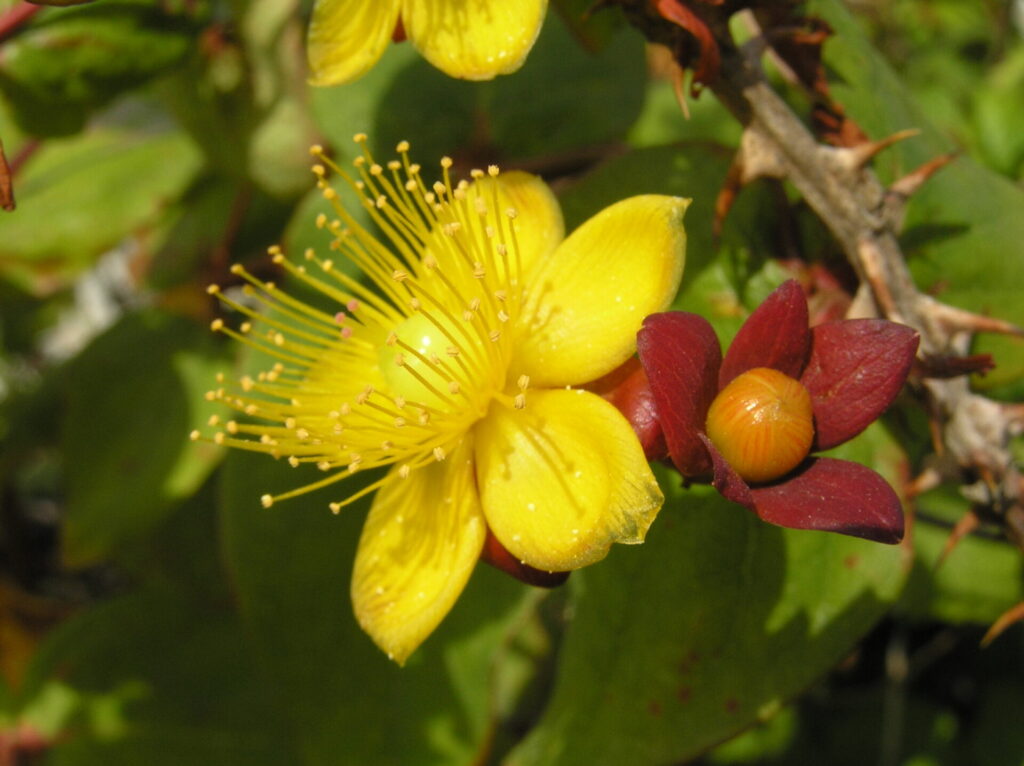
The family Hypericaceae has only one genus: Hypericum and the most useful plant in this genus is the St John’s Wort or Hypericum perforatum.
But there are other species with medicinal uses as you can read on the next page and many shrubby Hypericums in particular make good garden shrubs with simple yellow flowers and often attractive fruits. These are often arrived on the B.I. as a garden shrub and then spread succesfully in the wild.
The herbaceous Hypericums are pretty wildflowers too, worth growing in an ornamental border and also as I found out from this blog that their pollen is good food for bees:
“I love Hypericum shrubs. I adore the cheerful yellow flowers and the berries afterwards (the seeds inside the berries are eaten by some bird species).
It can be quite comical to watch bees, especially fat bumble bee queens and large workers, landing, and almost bouncing on the stamens, which on some varieties are rather long – these are specimens I advise selecting for a bee garden.
Most often, I tend to notice honey bees and bumble bees on the flowers, although some solitary species may also be observed. Other pollinators like Hypericum too; especially hover flies.“
The Plant Atlas 2020 online describes 19 species of Hypericum + 1 hybrid and 2 subspecies of Hypericum maculatum. You’ll find all the species on the next page and the descriptions of the more common species.
Information is used from the Plant Atlas Online mainly on the habitat of the plant and the link on the scientific name gets you to this website page. Pictures of the plant can often be found in the Gallery of the website. The link on the common name gets you to Wikipedia or any other often UK website. Pictures by Mike Poulton or Wikipedia Commons. A special thank you to https://cambridgewildflowers.blogspot.com/ where you can find good descriptions and pictures of the various Hypericums.
Blue background for the habitat and wildlife notes. Green background for various uses and pink background for medicinal use. FBBC added behind name in Contents if plant is mentioned or found in the Birmingham and Black Country Flora.
In Stace the genus Hypericum is subdivided into 9 sections; each section having things in common, mostly in the way the plant looks.
Contents:
Section 1 Ascyreia:
Hypericum calycinum or Rose of Sharon FBBC
H. pseudohenryi or Irish Tutsan FBBC
H. forrestii or Forrest’s Tutsan
H. x hidcoteense or Hidcote St John’s Wort FBBC
Section 2 Androsaemum:
H. androsaemum or Tutsan FBBC
H. x inodorum or Tall Tutsan FBBC
H. hircinum or Stinking Tutsan FBBC
Section 3 Inodora:
H. xylosteifolium or Turkish Tutsan
Section 4 Hypericum:
H. perforatum or Perforate St John’s Wort FBBC
H. maculatum or Imperforate St John’s Wort and FBBC
- H. maculatum ssp. maculatum
- H. maculatum ssp. obtusiusculum
H. x desetangsii or Des Etangs’ St John’s Wort FBBC
H. x cereticae (H. perforatum x H. undulatum) or Hybrid St John’s Wort
H. undulatum or Wavy St John’s Wort
H. tetrapterum or Square-stalked St John’s Wort FBBC
Section 5 Oligostemma:
H. humifusum or Trailing St John’s Wort FBBC
H. linariifolium or Toadflax-leaved St John’s Wort and
H. × caesariense (H. humifusum × H. linariifolium) or Caesar St John’s Wort
H. olympicum or Mount Olympus St John’s Wort FBBC
Section 6 Taeniocarpum:
H. pulchrum or Slender St John’s Wort FBBC
H. nummularium or Round-leaved St John’s Wort
H. hirsutum or Hairy St John’s Wort FBBC
Section 7 Adenosepalum:
H. montanum or Pale St John’s Wort
Section 8 Elodes:
H. elodes or Marsh St John’s Wort FBBC
Section 9 Spachium:
H. canadense or Irish St John’s Wort
Section 1 Ascyreia:
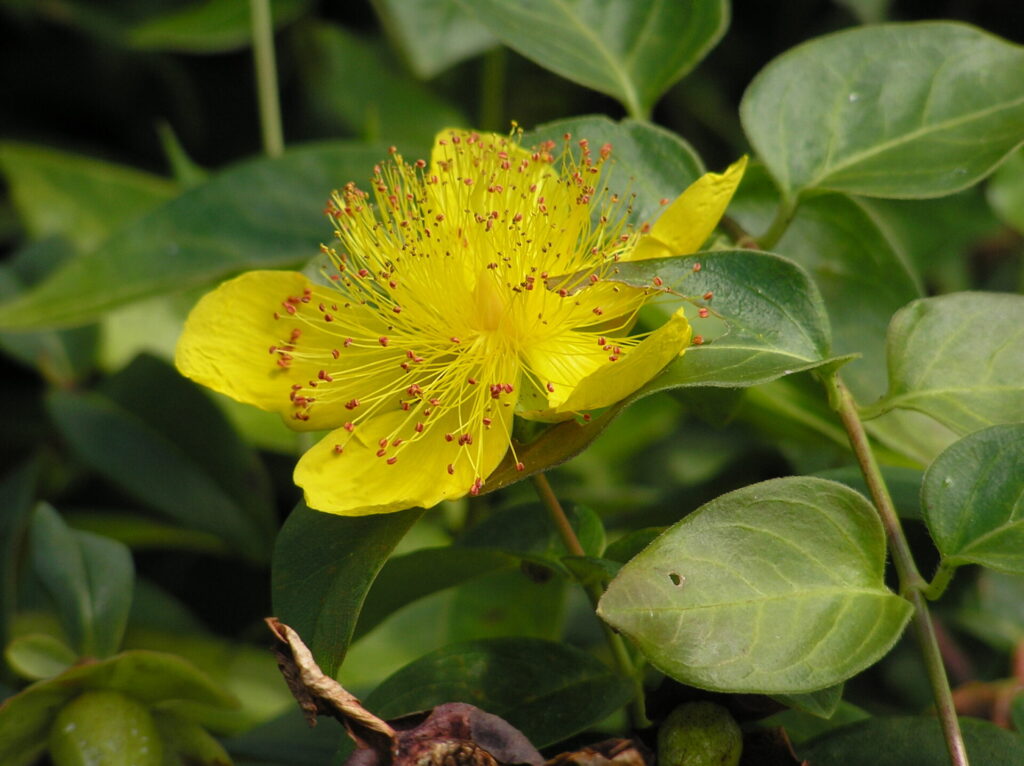
Hypericum calycinum or Rose of Sharon (Neophyte)
A low-growing, winter-green shrub, spreading vigorously by rhizomes and widely cultivated as ground cover and naturalized in hedgerows and on roadsides, ditches, waste ground and railway banks.
Hypericum calycinum is indigenous to southeast Europe and southwest Asia.
It is a popular, semi-evergreen groundcover plant.
This species has been used traditionally to reduce muscle spasms and for the treatment of asthma.
It is visited by the honeybees for its pollen.
Recent research on mice has shown that the alcoholic extracts from H. calycinum have antidepressant effects and are comparably as effective as antidepressant drugs. Unlike the rest of the genus, H. calycinum does not have hypericin, which causes photosensitization, which causes the side effects of flush, fatigue, and pruritus when used in drugs. These extracts have the potential to be a remedy for depression without these side effects common in current antidepressants. However, more research is required.
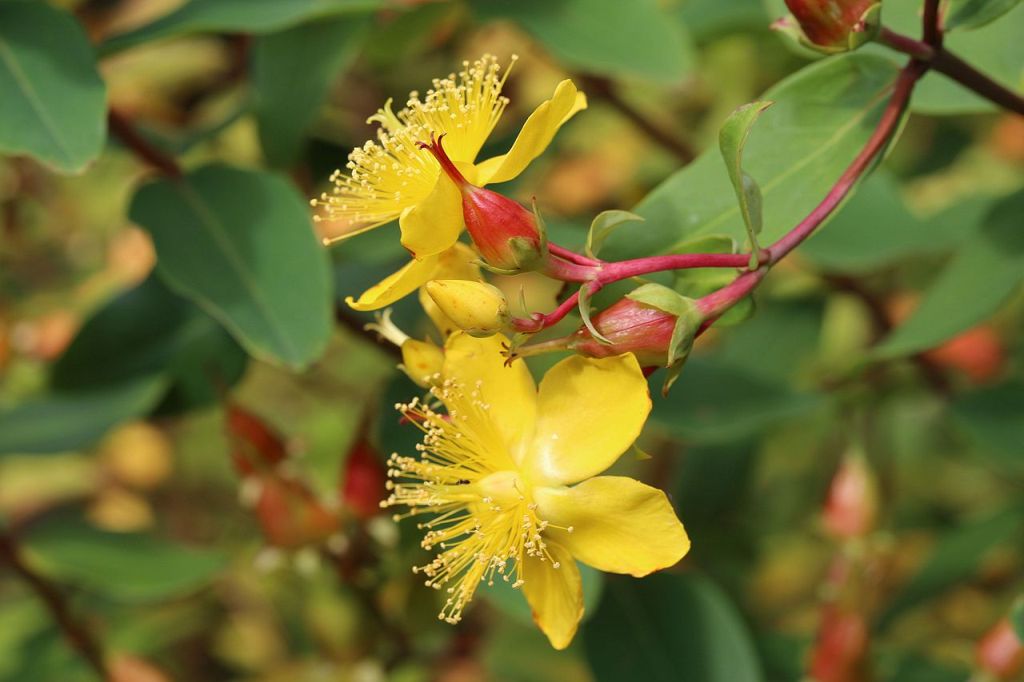
H. pseudohenryi or Irish Tutsan (Neophyte)
This is endemic to China. The species has been awarded the Royal Horticultural Society’s Award of Garden Merit
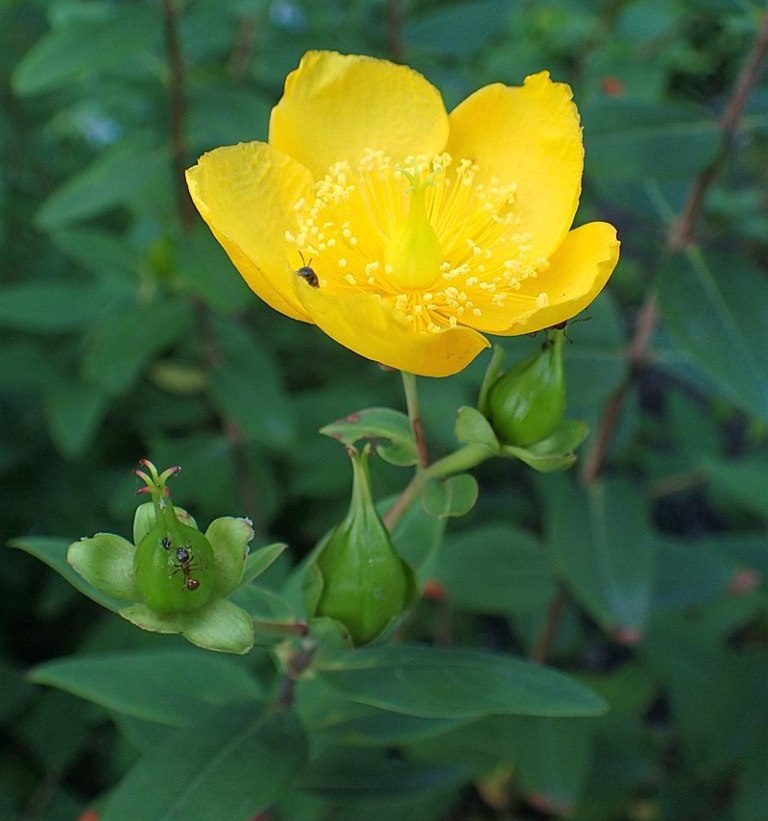
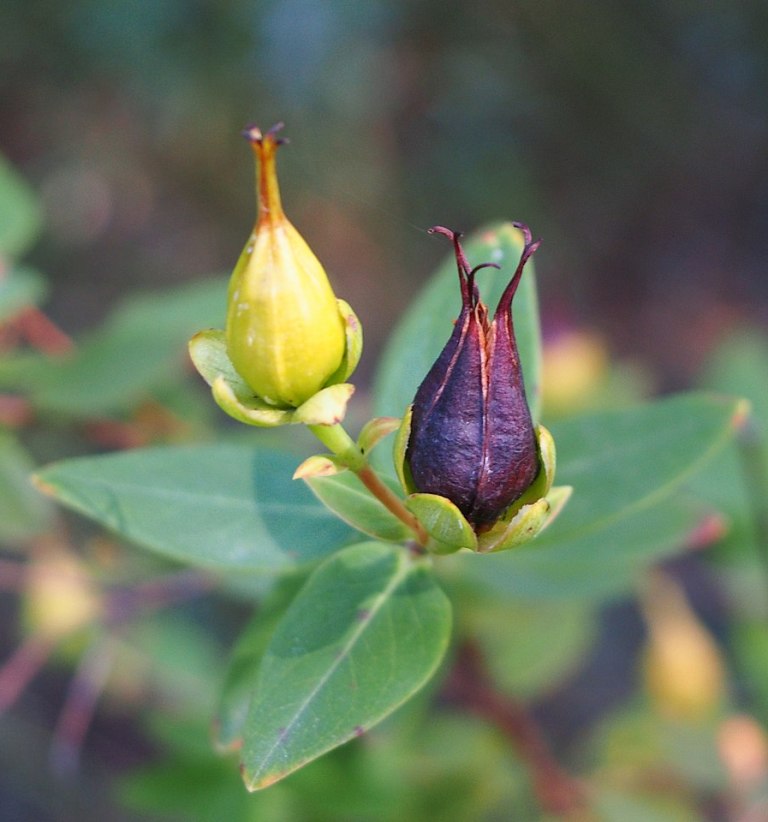
H. forrestii or Forrest’s Tutsan (Neophyte)
This species is also native to China and Myanmar. It was named in honour of the Scottish botanist George Forrest (1873-1932), who was the first westerner to discover it. The species has gained the Royal Horticultural Society‘s Award of Garden Merit.
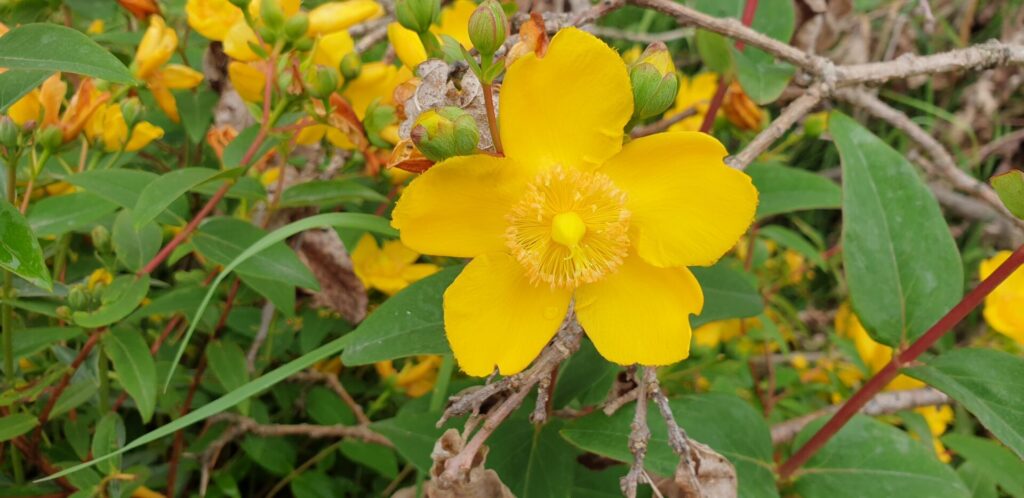
Close-up, flowering shoots and a naturalized plant of Hidcote St John’s Wort (by Mike Poulton)
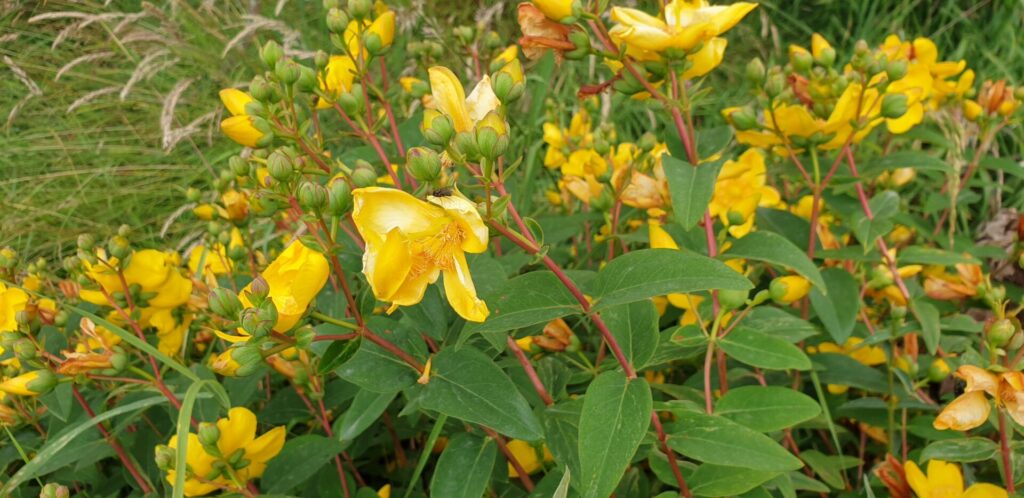
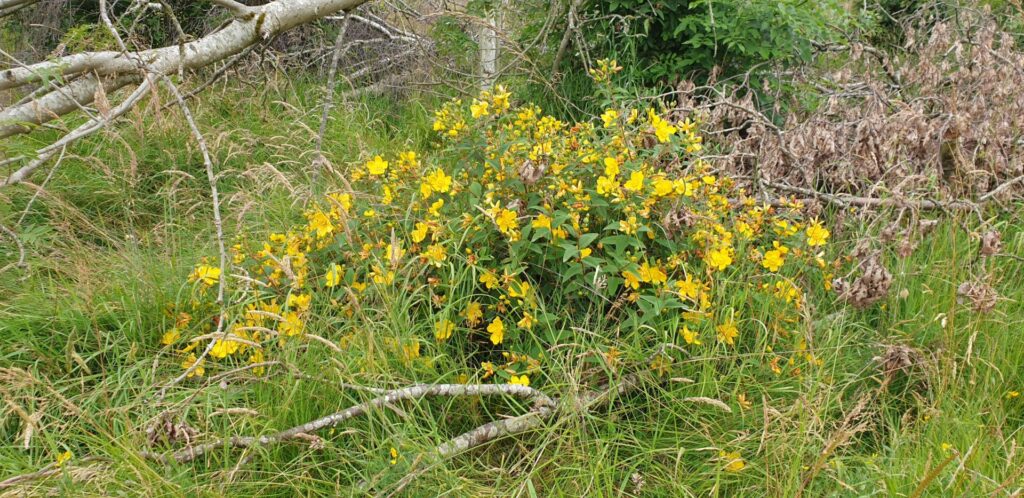
H. x hidcoteense or Hidcote St John’s Wort
This beautiful shrub has an AGM (Award Garden Merit) by the Royal Horticultural Society:
Masses of golden-yellow, cup-shaped flowers smother this evergreen or semi-evergreen shrub from July to October, creating a superb, long-lasting display. Perfect for the mixed or shrub border, where it will flourish in either full sun or partial shade. Dense and bushy in habit, it requires moderately fertile, moist but well-drained soil and will appreciate protection from cold, drying winds. Hypericum × hidcoteense ‘Hidcote’ makes a reliable standalone and multi-season low hedge, or as part of a mixed shrubbery where privacy or screening is required.
Section 2 Androsaemum:
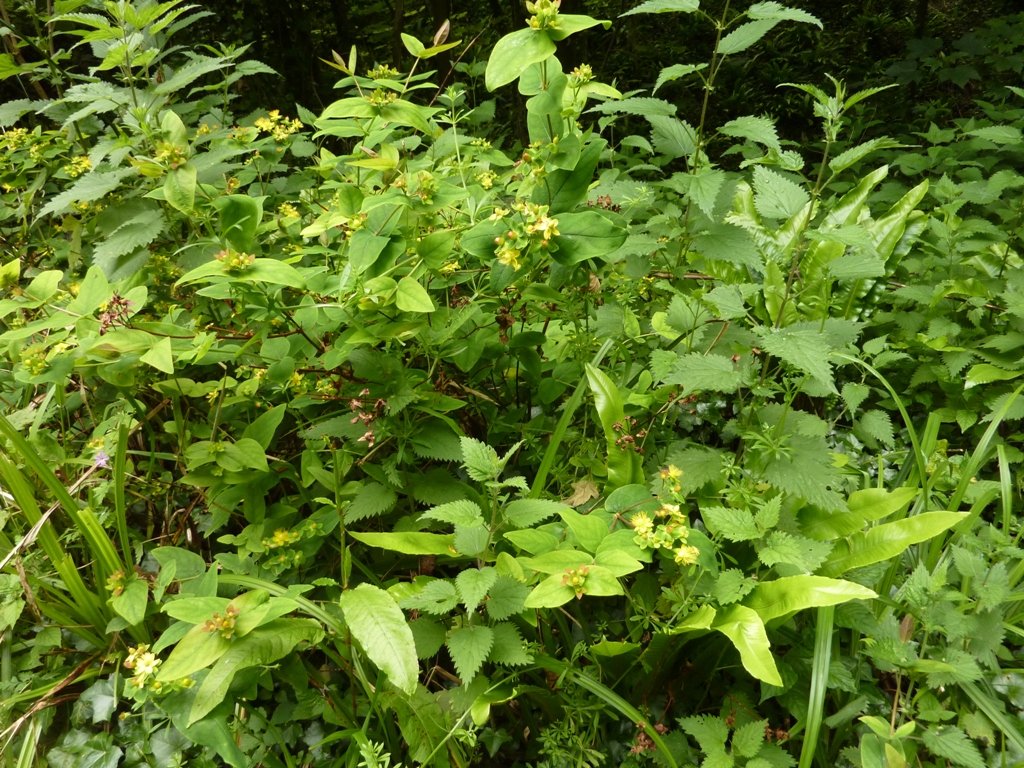
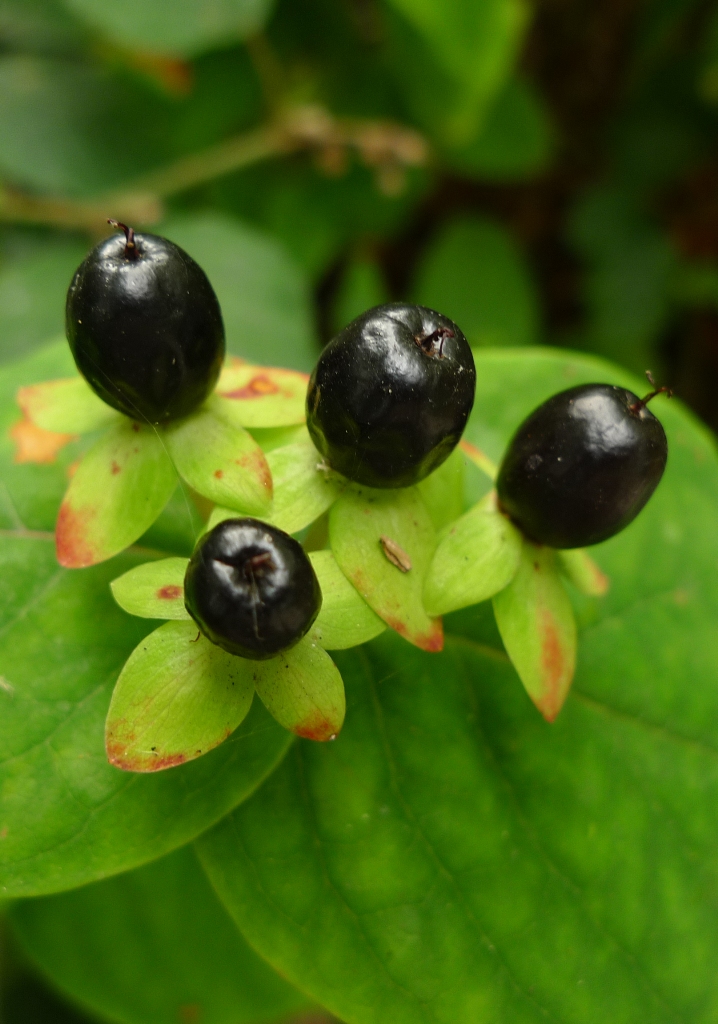
H. androsaemum or Tutsan (Neophyte)
A shrub of damp or shaded habitats including woods and hedgerows. It is also widely cultivated and occurs well outside its native range in semi-natural and artificial, often drier habitats, being apparently spread by birds and in water along streams and rivers.
The plant is native to Western Europe, North Africa and the Middle East, but has been introduced elsewhere in temperate areas with high rainfall, including Australia and New Zealand.
H. x inodorum or Tall Tutsan (H. androsaemum × hircinum)
A number of × inodorum cultivars have been produced which primarily differ from each other in plant habit and fruit color.
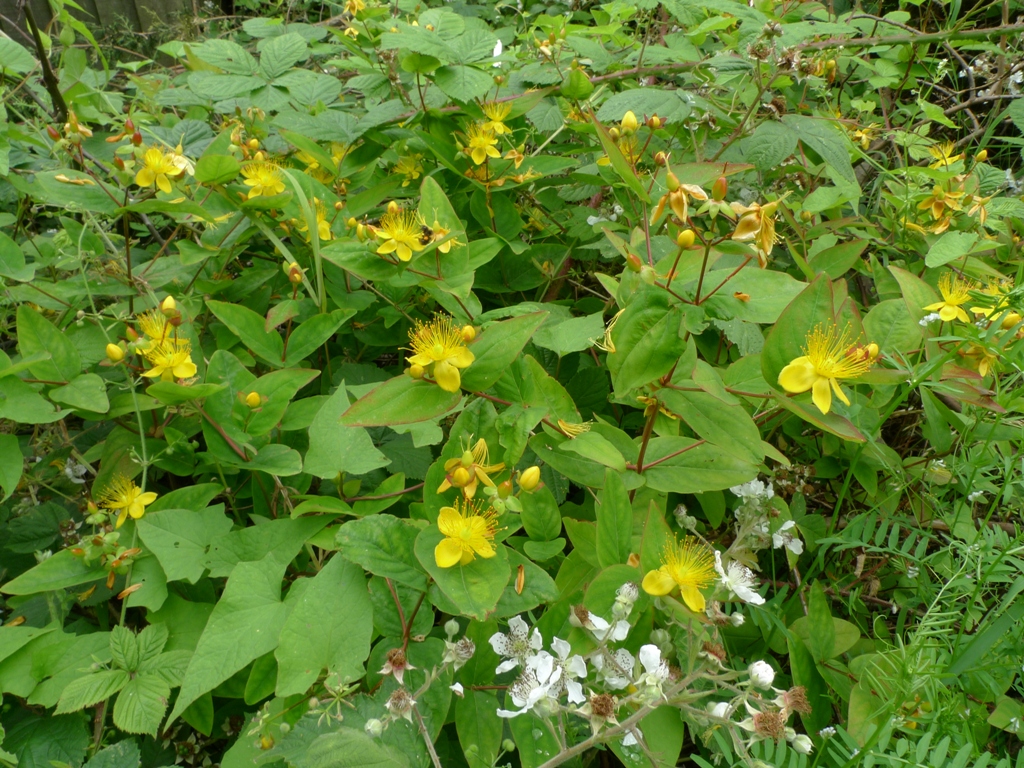
H. hircinum or Stinking Tutsan in habitat above, flowering tip below. (by Mike Poulton)
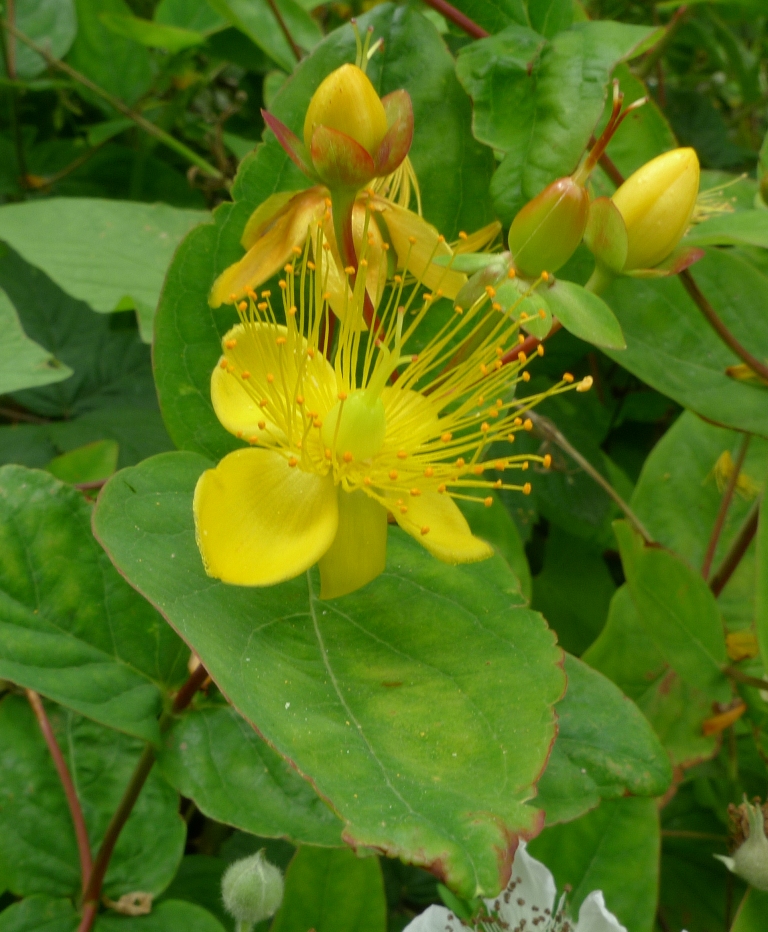
H. hircinum or Stinking Tutsan (Neophyte)
A partially winter-green shrub, widely grown in gardens and naturalized in shaded areas near to human habitations, and occasionally also in more open places where its growth is often stunted. Usually a relic of cultivation but there are reports of it self-seeding outside gardens.
While Hypericum hircinum lacks the high concentrations of several phytochemicals found in other members of its genus, it still has a highly active and useful chemical profile. Extracts from the species contain the highest levels of chemicals when taken from the flowering structures during the fruiting period of the plant. They have been used in folk medicine to treat respiratory diseases by ingestion, and it is also applied topically to treat burns and muscle ailments. Modern evaluations have demonstrated the plant’s effectiveness as an antioxidant, anti-collagenase (for cosmetic care), and antimicrobial agent.
Section 3 Inodora:
H. xylosteifolium or Turkish Tutsan (Neophyte)
Section 4 Hypericum:
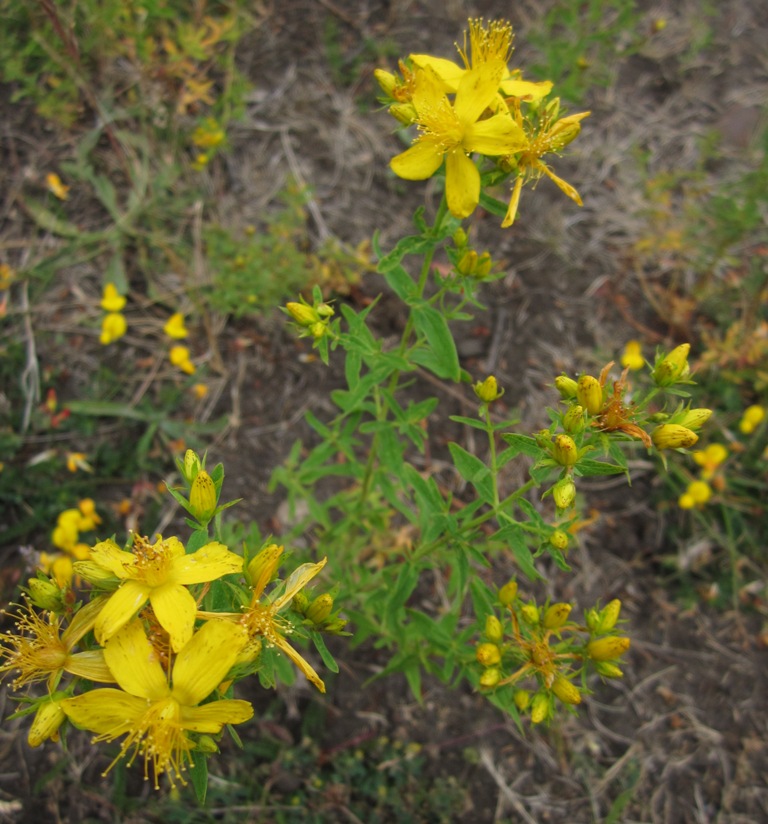
Flowering stems of H. perforatum or Perforate St John’s Wort (by Mike Poulton)

H. perforatum or Perforate St John’s Wort
A variable, rhizomatous perennial herb of meadows, hedgebanks, open woods, roadsides and wasteland. It often grows in drier, more ruderal and more calcareous habitats than H. maculatum. It reproduces by seed and also sometimes by root buds.
Produces masses of orange pollen as each flower has predominantly stamens, and is loved by all bees, but the flower yields no nectar.
The use of this species as an herbal remedy to treat a variety of internal and external ailments dates back to the time of the ancient Greeks. Since then, it has remained a popular treatment for anxiety, depression, cuts, and burns. Recent research suggests the effectiveness of this herb in treating other ailments, including cancer, inflammation-related disorders, and bacterial and viral diseases, and as an antioxidant and neuroprotective agent.
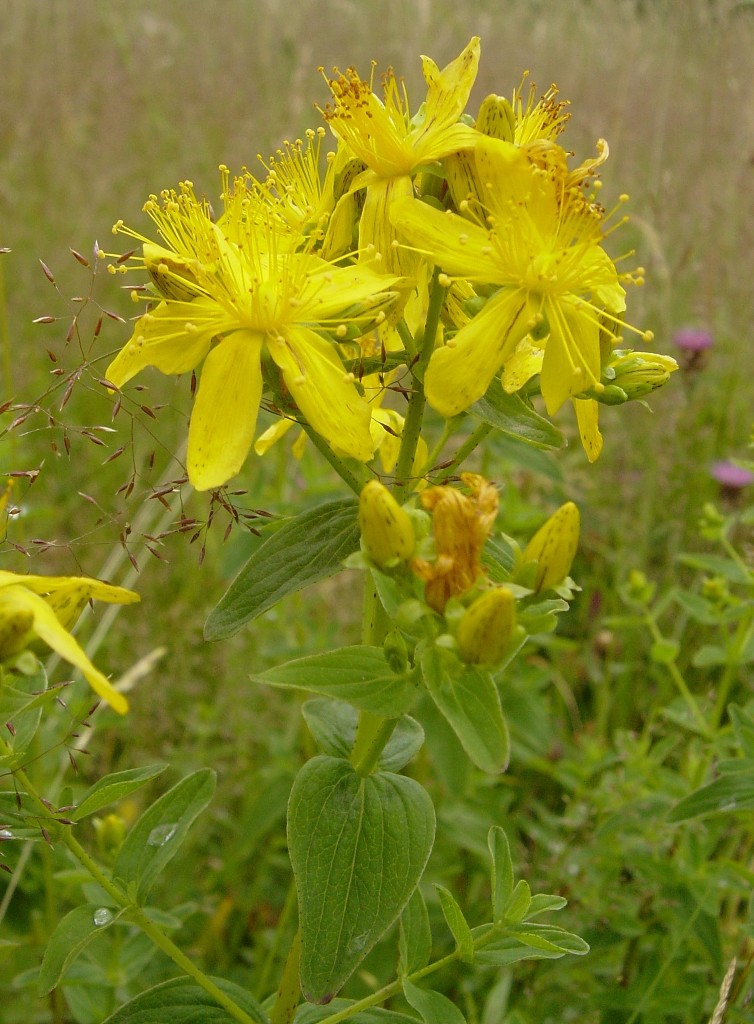
H. maculatum or Imperforate St John’s Wort
A shortly rhizomatous perennial herb growing in damp shaded places, but also in more ruderal habitats such as quarries, waste ground and rough, grassy places.
It is considered to be a medicinal plant. Hypericum maculatum herb has been used in the traditional Austrian medicine internally as tea or oil extract, and externally as oil extract, ointment or cold maceration in ethanol for treatment of disorders of the skin, locomotor system, nervous system, gastrointestinal tract, respiratory tract, kidneys and urinary tract, cardiovascular system, infections, rheumatism and gout.
H. x desetangsii (H. maculatum × perforatum) or Des Etangs’ St John’s Wort
A perennial herb, intermediate in form between its parents, occurring in rough grassland, gravel- and colliery-pits, on roadsides and railway banks. Because the habitats of the parents rather widely overlap, it often occurs with one or other of them, but can also be found in their absence.
H. undulatum or Wavy St John’s Wort and
H. x cereticae (H. perforatum x H. undulatum) or Hybrid St John’s Wort
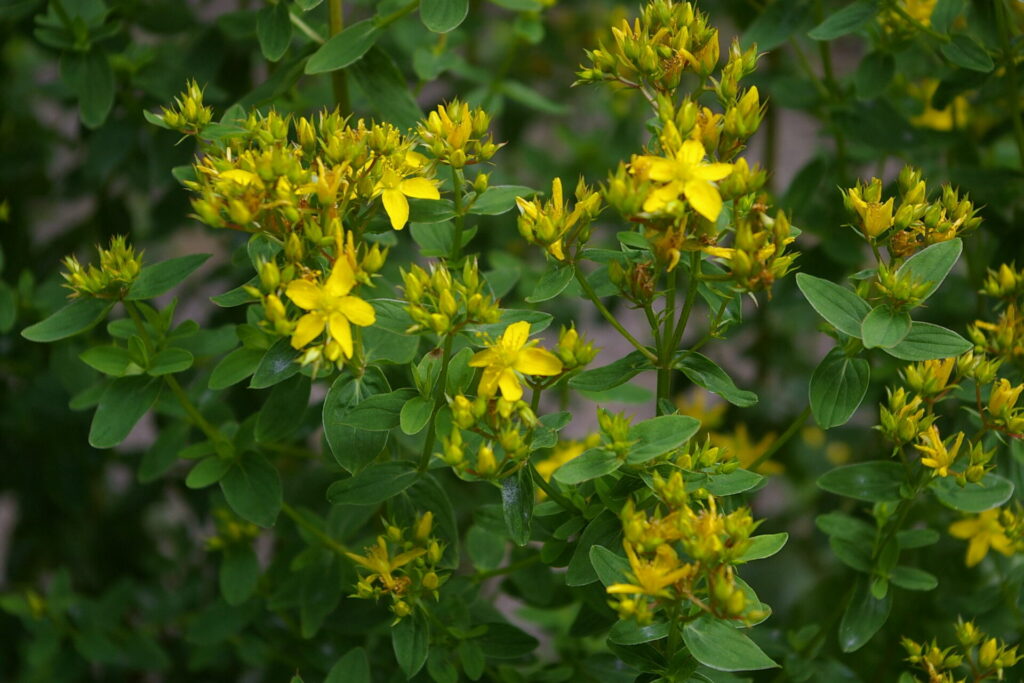
H. tetrapterum or Square-stalked St John’s Wort
A shortly rhizomatous perennial herb of eutrophic damp or wet habitats including damp meadows and woodland rides, gravel-pits, marshes, streamsides and open ditches. It is also rarely recorded as a nursery weed (Leslie, 2019).
A common but attractive wildflower.
Section 5 Oligostemma:
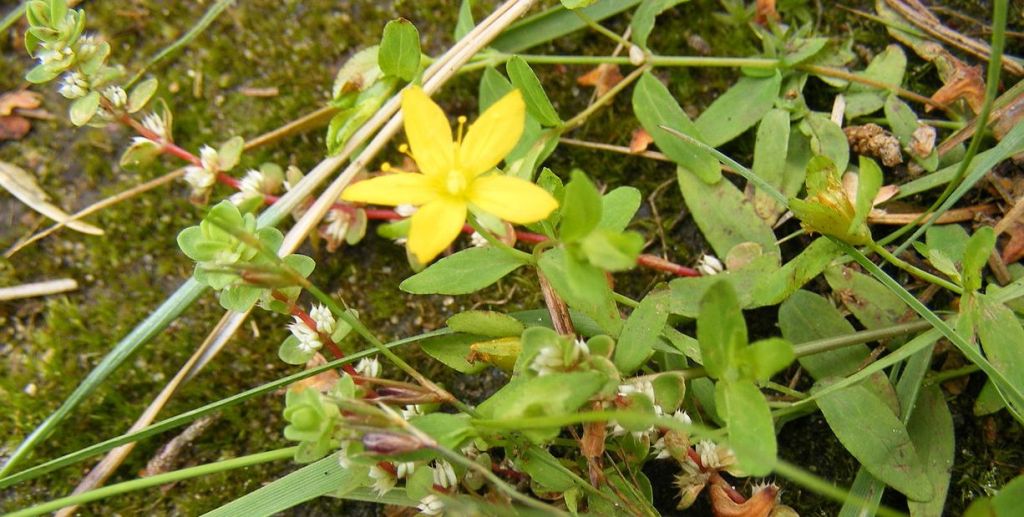
H. humifusum or Trailing St John’s Wort
A short-lived perennial herb of open well-drained habitats on light acidic soils including acid grasslands, heathlands, open woodlands, tracksides, and occasionally roadside banks; if apparently on calcareous soils, then rooting in a shallow acidic surface layer.
H. linariifolium or Toadflax-leaved St John’s Wort (native but rare!) and
H. x caesariense (H. humifusum × H. linariifolium) or Caesar St John’s Wort
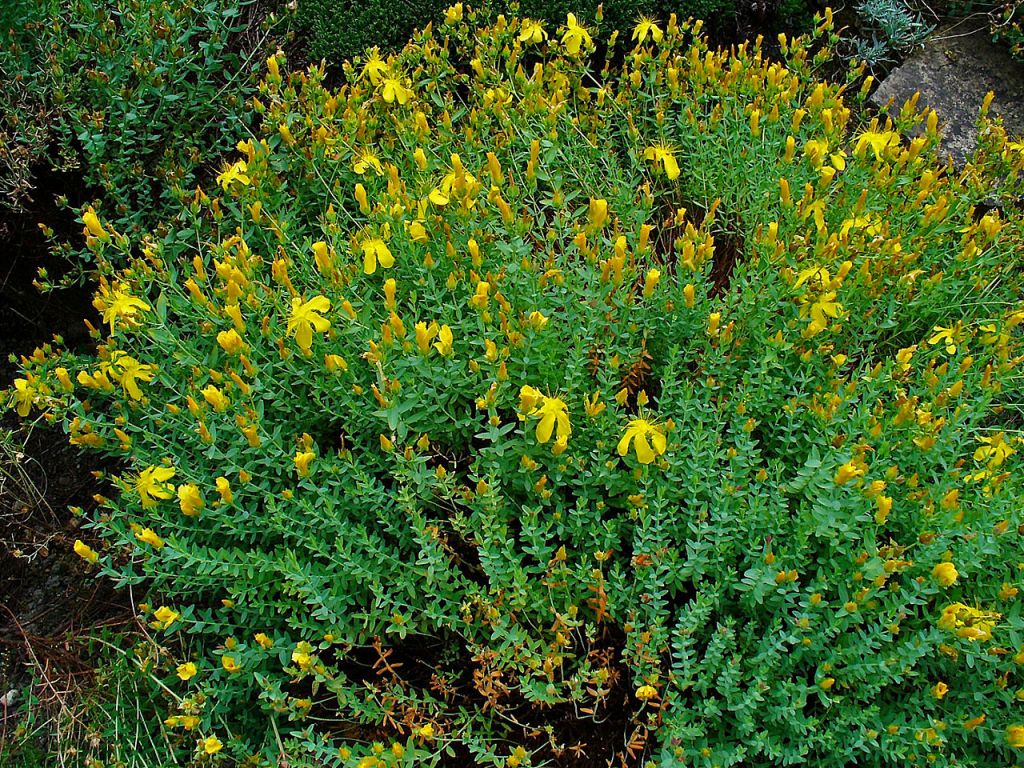
H. olympicum or Mount Olympus St. John’s wort (Neophyte)
A winter-green dwarf shrub or woody-based perennial herb, widely grown in gardens and found self-sown on walls, paths, pavements, spoil heaps and waste ground usually close to habitation.
Because of its large, showy flowers, relative hardiness, and dense shape, the species is valued among gardeners, specifically here in the United Kingdom. It has been noted for these properties and won several awards, including in 1930, under the incorrect name of H. fragile, winning the Royal Horticultural Society‘s Award of Garden Merit.
While the species is not at all harmful to humans, it can be toxic to dogs, cats, and horses, and should be planted away from such animals.
Section 6 Taeniocarpum:
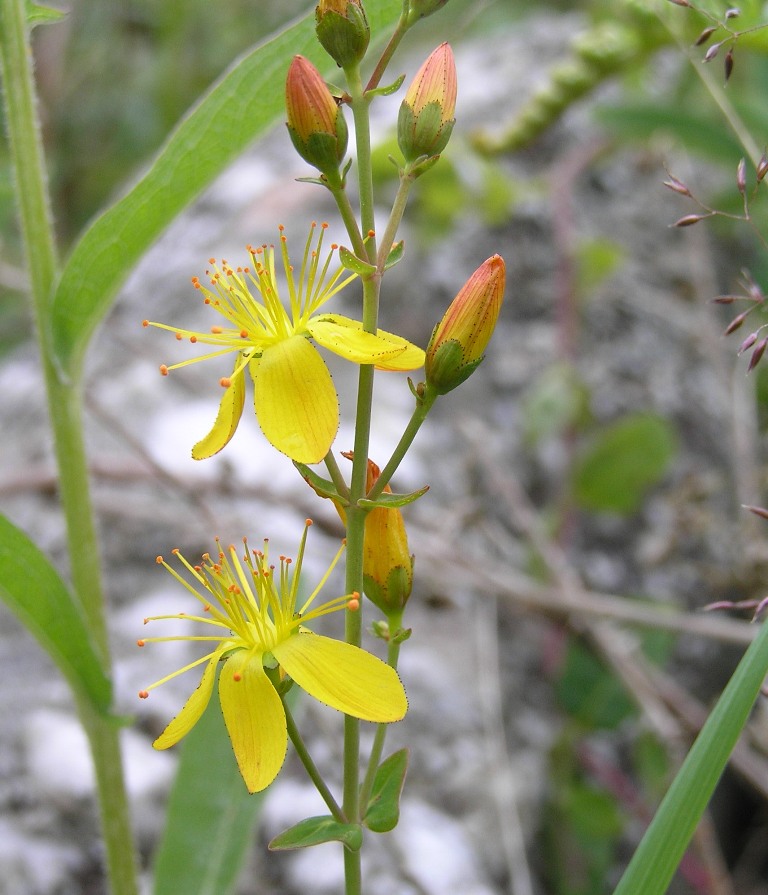
H. pulchrum or Slender St John’s Wort
A perennial herb of heathlands, sand dunes and open woods on non-calcareous, fairly dry, sandy, peaty, or leached soils. Reproduction is by seed, and budding from the roots sometimes occurs. A dwarf form with prostrate to procumbent stems (f. procumbens) occurs in exposed habitats in northern and western Scotland and in islands off western Ireland.
H. nummularium or Round-leaved St John’s Wort (Neophyte and rare)
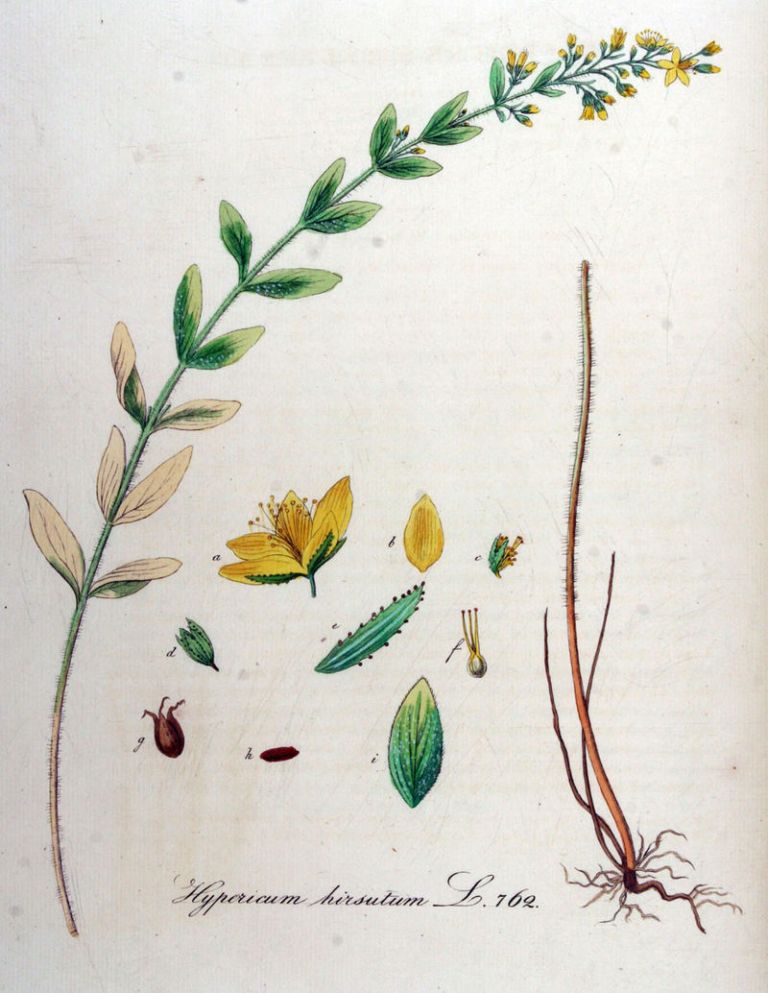
H. hirsutum or Hairy St John’s Wort
A perennial herb of well-drained, neutral to basic soils in open or partially shaded habitats including rough and ungrazed grassland, woodland rides and clearings, riverbanks, roadside banks and verges.
Section 7 Adenosepalum:
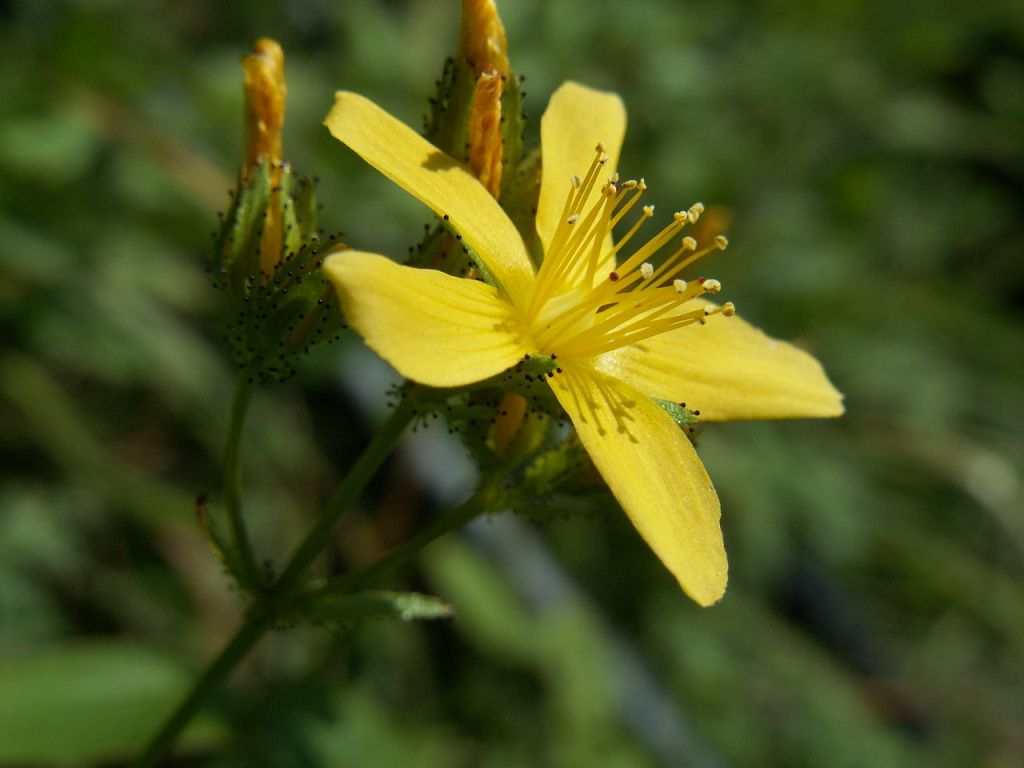
H. montanum or Pale St John’s Wort
A perennial herb confined to chalk and limestone districts, and only occasionally found over other substrates. It prefers warm, well-drained soils, and grows by hedges and in thickets, amongst scrub, in rough grassland, open woodland and rides, old quarries and the grikes of limestone pavement. Reproduction is by seed, and vegetative spread is very slow.
Section 8 Elodes:
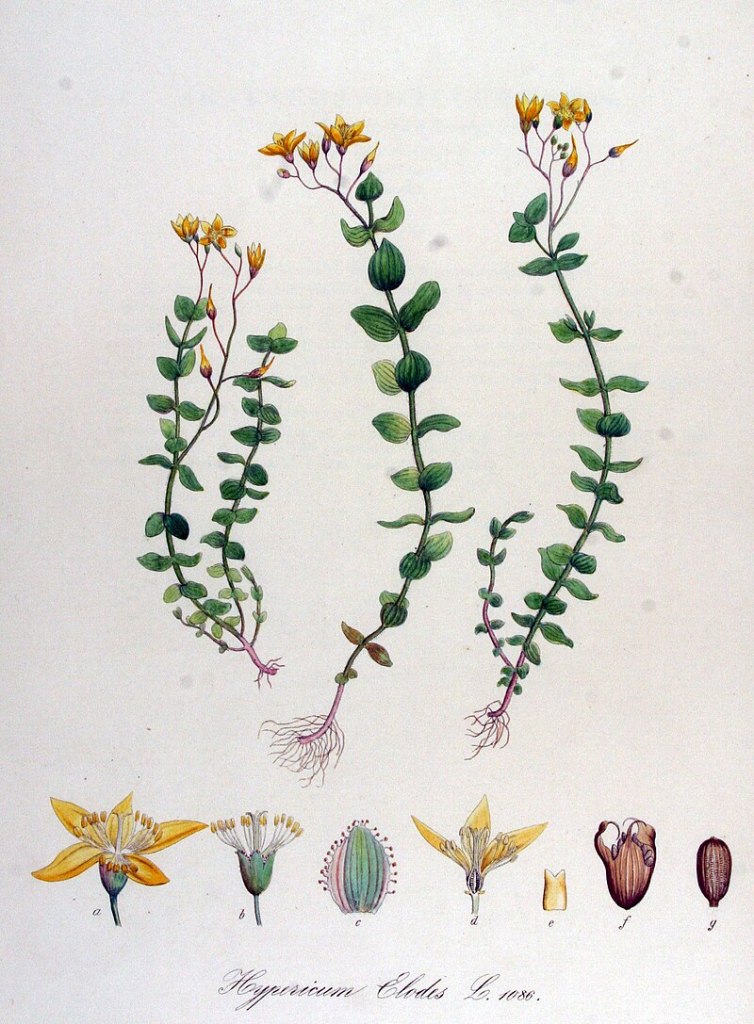
H. elodes or Marsh St John’s Wort
A stoloniferous perennial herb of peat or peaty mineral soils in damp or wet acidic, nutrient-poor habitats, usually found in shallow water, but sometimes as a terrestrial plant on damp mud, or in deeper water where it may form floating mats. It occurs in heathland pools, on the swampy margins of ponds and slow-flowing streams, and along flushes, runnels and soakaways in mires, acid basin mires, and the more acidic parts of poor fen in valley mires.
Section 9 Spachium:
H. canadense or Irish St John’s Wort (rare Neophyte in Ireland)
Apparently to Wikipedia this plant has been introduced to Ireland and The Netherlands.
